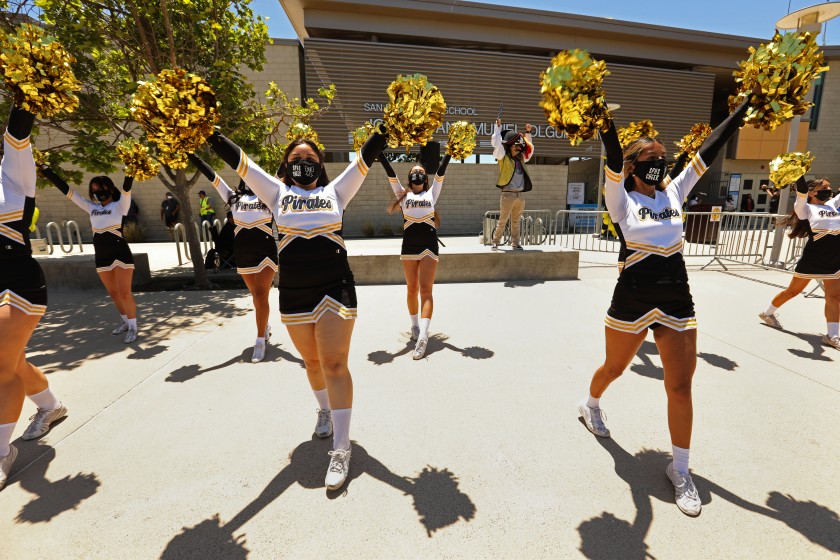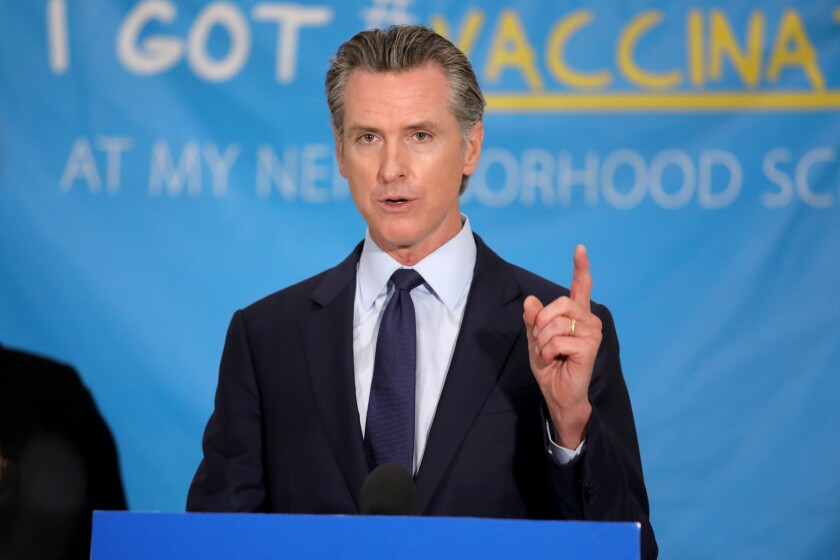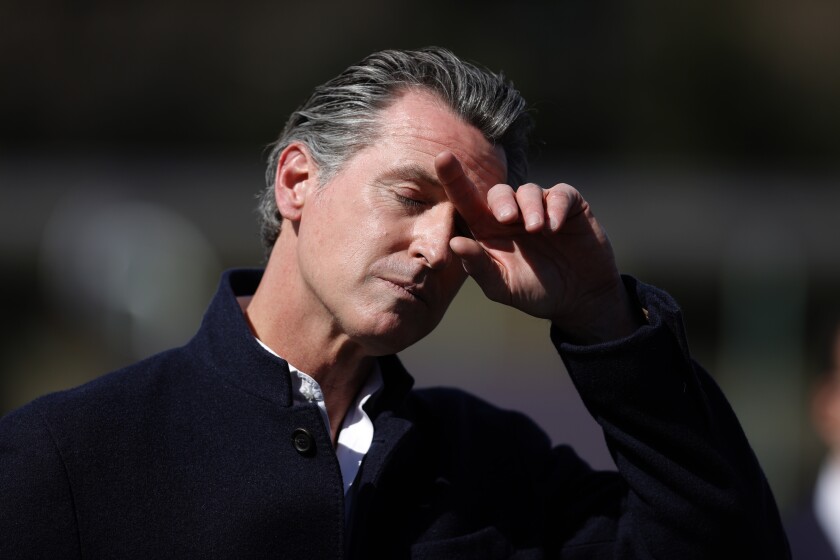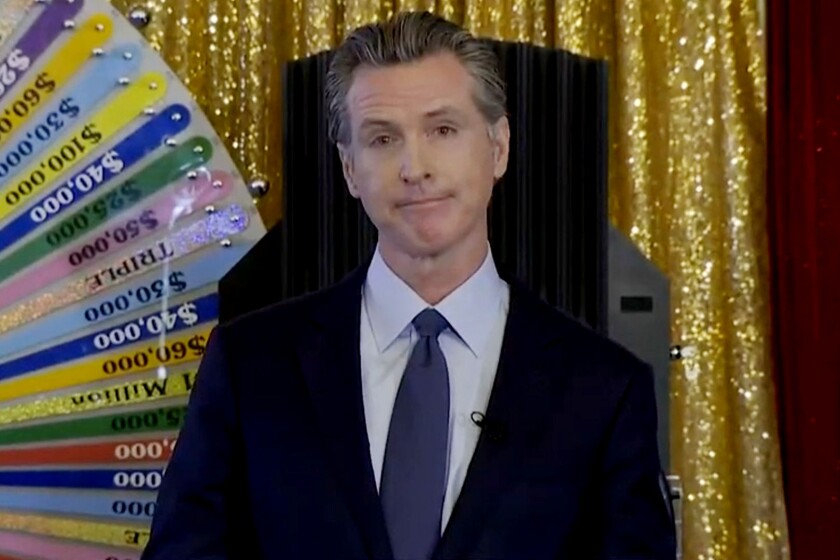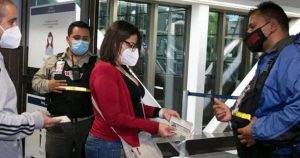California is one of only two states considered to have low levels of community coronavirus transmission, a designation that underscores its continued progress toward extinguishing the pandemic a week ahead of the planned reopening.
The assessment from the U.S. Centers for Disease Control and Prevention is based on the number of new cases confirmed statewide over the last week as well as the rate at which conducted tests were coming back positive.
The CDC categorizes low transmission as when a state’s seven-day case rate is under 10 per 100,000 residents and its rate of positive test results is less than 5%. Among all 50 states, only California and Vermont meet both those benchmarks, federal figures show.
As of Sunday, California’s seven-day case rate per 100,000 people was 9.1, trailing Vermont’s 8.3.
By comparison, case rates over the same period were 34.5 in Florida, 30.6 in Pennsylvania, 26.8 in Texas, 21 in New York City and 22.7 in the rest of New York state.
Here are five things to expect as L.A. County fully reopens after COVID-19 restrictions.
For more than a month, California has been among states with the lowest coronavirus case rates — a dramatic turnaround from the fall and winter, when a viral tsunami overwhelmed the state and pushed hospitals close to the breaking point.
The progress California has made is particularly pronounced when looking at raw case counts.
During the height of the last surge, the state was recording, on average, more than 40,000 new cases per day. Over the past week, California has reported a daily average of about 900 new cases, data compiled by The Times show.
According to the CDC, the vast majority of the nation falls in the much broader category of moderate transmission, recording rates of positive test results from 5% to 7.99% and case rates from 10 to 49.99.
Only three states — Wyoming, Colorado and Washington — are considered to have substantial transmission; all three have seven-day case rates that are over 50 per 100,000 residents.
During a briefing last week, CDC Director Dr. Rochelle Walensky said the nationwide weekly average of newly confirmed coronavirus cases had fallen by 94% since its peak in January.
“This is the type of news I like to deliver,” she said Thursday, “and certainly these data are encouraging and uplifting as we battle this pandemic.”
The state’s economy will reopen, but ‘the disease has not been extinguished,’ governor says.
Despite the state’s strides, however, Gov. Gavin Newsom said Friday the danger posed by COVID-19 had not evaporated.
“This disease has not been extinguished,” he said. “It’s not vanished. It’s not taking the summer months off.”
Newsom also said California’s state of emergency order — which gives him and health officials broad authority to temporarily impose new rules and restrictions — would remain in place beyond what had been billed as the state’s full reopening on June 15.
The governor’s office later said that preserving the emergency declaration “ensures that the state can continue to respond quickly to evolving conditions as the pandemic persists” and that Newsom would end it “once conditions no longer warrant an emergency response.”
The revelation drew swift condemnation from Republicans, who have long objected to the scope of Newsom’s emergency powers.
The COVID-19 changes promised to take effect in California on June 15 are the beginning, not the end, of the effort to return to normality.
State officials have said the progress California has made, as well as its long-sought wide reopening, has been made possible through the continued rollout of COVID-19 vaccines.
California is one of 13 states where 70% or more adults have received at least one vaccine dose, a threshold the Biden administration is seeking to hit nationwide by July 4.
However, more work needs to be done. About 68% of eligible Californians 12 and older have gotten at least one shot, but only 52.4% are fully vaccinated — meaning they either received the single-dose Johnson & Johnson vaccine or both required doses of Pfizer-BioNTech or Moderna.
And with the inoculation campaign now more than 5 months old, experts and officials acknowledge that reaching those who have yet to roll up their sleeves will be challenging and entail both tearing down any remaining barriers to vaccine access and knocking down concerns or misinformation surrounding the shots’ efficacy or safety.
“Getting from 30% to 40% of people vaccinated, that’s an easy 10%,” Newsom said recently. “Moving from 70% of adults to 75% and beyond, that’s stubborn. That’s difficult work.”
Gov. Gavin Newsom, facing a recall election, draws the names of the first winners of California’s COVID-19 vaccine lottery in an upbeat event.
State officials are hoping the chance for cash will be enough to tempt some of the remaining holdouts.
On Friday, the initial winners of the state’s vaccine lottery were drawn — with 15 Californians securing $50,000 prizes.
Another 15 $50,000 winners will be selected this Friday, and the drawings will conclude June 15, when 10 residents will win $1.5 million each.
As part of the $116.5-million incentive program, 2 million vaccine recipients (those with a first shot as of May 27 or later) will also be eligible for either a $50 prepaid gift card or a $50 grocery card.
California’s ‘Vax for the Win’ program seeks to boost interest in vaccines by offering cash rewards. If you’ve gotten a shot, you’re already eligible.
Though it’s likely too soon to determine whether the 12-day-old program is having the desired effect — there’s a delay in accounting for all the vaccines administered, and the recent Memorial Day holiday weekend may have skewed the data — California is not alone in turning to prizes in hopes of boosting flagging inoculation rates.
States and private companies across the country are offering a variety of items, including cash giveaways and free beer, in hopes of getting more Americans inoculated.
“If you’re on the fence,” Newsome said, “if you’re just a little bit hesitant or you just were unwilling in the past but all of a sudden you think, ‘Wait a second, I could really use $50,000,’ we’re doing all this to encourage that and to get you to think anew and, hopefully, act anew.”
